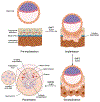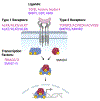Endometrial TGFβ signaling fosters early pregnancy development by remodeling the fetomaternal interface
- PMID: 38009061
- PMCID: PMC10683870
- DOI: 10.1111/aji.13789
Endometrial TGFβ signaling fosters early pregnancy development by remodeling the fetomaternal interface
Abstract
The endometrium is a unique and highly regenerative tissue with crucial roles during the reproductive lifespan of a woman. As the first site of contact between mother and embryo, the endometrium, and its critical processes of decidualization and immune cell recruitment, play a leading role in the establishment of pregnancy, embryonic development, and reproductive capacity. These integral processes are achieved by the concerted actions of steroid hormones and a myriad of growth factor signaling pathways. This review focuses on the roles of the transforming growth factor β (TGFβ) pathway in the endometrium during the earliest stages of pregnancy through the lens of immune cell regulation and function. We discuss how key ligands in the TGFβ family signal through downstream SMAD transcription factors and ultimately remodel the endometrium into a state suitable for embryo implantation and development. We also focus on the key roles of the TGFβ signaling pathway in recruiting uterine natural killer cells and their collective remodeling of the decidua and spiral arteries. By providing key details about immune cell populations and TGFβ signaling within the endometrium, it is our goal to shed light on the intricate remodeling that is required to achieve a successful pregnancy.
Keywords: decidualization; endometrium; pregnancy; pregnancy loss; transforming growth factor β; uterine natural killer cells.
© 2023 John Wiley & Sons A/S. Published by John Wiley & Sons Ltd.
Conflict of interest statement
Conflict of Interest Statement
The authors have no conflicts of interest to declare.
Figures


Similar articles
-
TGFβ superfamily signaling and uterine decidualization.Reprod Biol Endocrinol. 2017 Oct 13;15(1):84. doi: 10.1186/s12958-017-0303-0. Reprod Biol Endocrinol. 2017. PMID: 29029620 Free PMC article. Review.
-
Integral Roles of the TGFβ Signaling Pathway in Uterine Function and Disease.Endocrinology. 2025 Feb 5;166(3):bqaf032. doi: 10.1210/endocr/bqaf032. Endocrinology. 2025. PMID: 39950970 Review.
-
Tissue inhibitor of matrix metalloproteinase-3 expression in the mouse uterus during implantation and artificially induced decidualization.Mol Reprod Dev. 2001 Jun;59(2):159-67. doi: 10.1002/mrd.1018. Mol Reprod Dev. 2001. PMID: 11389550
-
Periconceptional exposure to lopinavir, but not darunavir, impairs decidualization: a potential mechanism leading to poor birth outcomes in HIV-positive pregnancies.Hum Reprod. 2020 Aug 1;35(8):1781-1796. doi: 10.1093/humrep/deaa151. Hum Reprod. 2020. PMID: 32712670 Free PMC article.
-
TGF-beta superfamily expression and actions in the endometrium and placenta.Reproduction. 2006 Aug;132(2):217-32. doi: 10.1530/rep.1.01076. Reproduction. 2006. PMID: 16885531 Review.
Cited by
-
In-Depth Analysis of miRNA Binding Sites Reveals the Complex Response of Uterine Epithelium to miR-26a-5p and miR-125b-5p During Early Pregnancy.Mol Cell Proteomics. 2025 Jan;24(1):100879. doi: 10.1016/j.mcpro.2024.100879. Epub 2024 Nov 12. Mol Cell Proteomics. 2025. PMID: 39536955 Free PMC article.
References
-
- Critchley HOD, Maybin JA, Armstrong GM, Williams ARW. Physiology of the Endometrium and Regulation of Menstruation. Physiol Rev. 2020;100(3):1149–1179. - PubMed
-
- McCartney CR, Marshall JC Neuroendocrinology of Reproduction 8th ed: Elsevier; 2019.
Publication types
MeSH terms
Substances
Grants and funding
LinkOut - more resources
Full Text Sources
Research Materials

